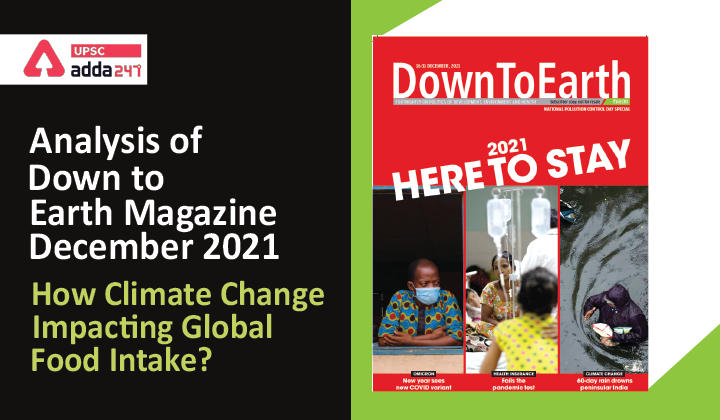Table of Contents
Relevance
”GS 3: Disaster Management, Environmental Pollution & Degradation, Environmental Impact Assessment (EIA)”
Context
- In early December, Food and Agricultural Organization (FAO) reiterated climate change’s role in jacking up food prices.
- According to FAO, The rise impacts the world’s poor even more because the pandemic has already pushed millions into the poverty trap and every third person in the world is not able to have adequate food.
Key Findings
- FAO find in its study that the average food prices (after adjusting for inflation) in the 11 months of 2021 were the highest in 46 years.
- The global food price rise was driven predominantly by wheat, which reported an increase due to drought and high temperatures in major producing countries, including the US and Canada.
- In 2021, as various trade reports show, spring wheat production declined by 40 per cent in the US due to drought and heat.
- Russia, the world’s largest exporter of wheat, is estimated to harvest less due to unfavourable weather conditions this season. Even It has imposed a tax on wheat export to ensure plenty of stock for domestic consumption.
- Every loss in agricultural production is equal to keeping food away from the needy. Due to disasters, the world is losing up to 4 per cent of the potential crop and livestock production. It converts into a loss of some 6.9 trillion kilocalories per year, or the annual calorie intake of 7 million adults, as per FAO.
How Climate Change Intensifies Risks to Food Security?
- Climate change affects food security in all its dimensions: access, availability, utilization and stability.
- Net effects of climate change on food security depend on vulnerabilities of affected systems
- As per the Intergovernmental Panel on Climate change (IPCC), climate change augments and intensifies risks to food security for the most vulnerable countries and populations.
- Four out of the eight key risks induced by climate change identified by IPCC AR5 have direct consequences for food security:
-
- Loss of rural livelihoods and income
- Loss of marine and coastal ecosystems, and livelihoods
- Loss of terrestrial and inland water ecosystems, and livelihoods
- Food insecurity and breakdown of food systems
How Climate Change is Impacting Agricultural Production?

- As per the study by FAO, apart from other major issues, Climate change is fuelling extreme and erratic weather events and prolonging drought and heatwaves. These lead to widespread crop damage and also affect crop yields in the long term.
- In the first two decades of this century, disasters have significantly increased— from 360 events a year in the 2000s to 440 in the 2010s. Only 100 disasters struck a year in the 1970s.
- Agriculture is by far the worst impacted sector by extreme weather events and disasters.
- In poor, low and middle-income countries, agriculture absorbed 26 per cent of medium- to large-scale disasters in 2008-18.
- According to the fao estimate, in 2008-18, poor-, low- and middle-income countries lost US $108.5 billion to disaster-induced decline in crop and livestock production.
- The impact of climate change on agriculture is twofold: First, it immediately leads to a reduction in production and in consumption. Both affect the availability of food and its price, resulting mostly in steep increases, as we experience currently. Second, if one interprets this loss in the context of poor, lower- and middle-income countries, it is a loss of 22 per cent of calorie intake daily due to disasters.
- So, climate change-induced disasters not only impact the farmers in terms of income loss but also reduce the availability of food. This is the climate food trap that captures every one of us.
What Should be Our Responses?
- Ensure food security and good nutrition in the context of climate change.
- Mobilize social protection to increase the resilience of livelihoods in the face of climate change.
- Agricultural systems can be made more resilient, by implementing measures that are very system- and local-specific.
- Increasing the efficiency of scarce resource use in production systems, particularly water, is an important aspect of building resilient livelihoods.
- Adaptation measures for crops can include the use of adapted varieties or breeds, with different environmental optima and/or broader environmental tolerances, including currently neglected crops, also considering that increased diversification of varieties or crops is a way to hedge against the risk of individual crop failure, etc.
Conclusion
The changes on the ground needed for adaptation to climate change in agriculture and food systems for food security and nutrition will require to be enabled by investments, policies and institutions in various areas. To be the most effective such interventions need to be part of integrated strategies and plans. The strategies should be gender-sensitive, multi-scales, multi sectors and multi-stakeholders. They should be elaborated in a transparent way and consider the different dimensions (social, economic, environmental) of the issues and different time scales by which the changes will need to be implemented and supported.



 TSPSC Group 1 Question Paper 2024, Downl...
TSPSC Group 1 Question Paper 2024, Downl...
 TSPSC Group 1 Answer key 2024 Out, Downl...
TSPSC Group 1 Answer key 2024 Out, Downl...
 UPSC Prelims 2024 Question Paper, Downlo...
UPSC Prelims 2024 Question Paper, Downlo...
